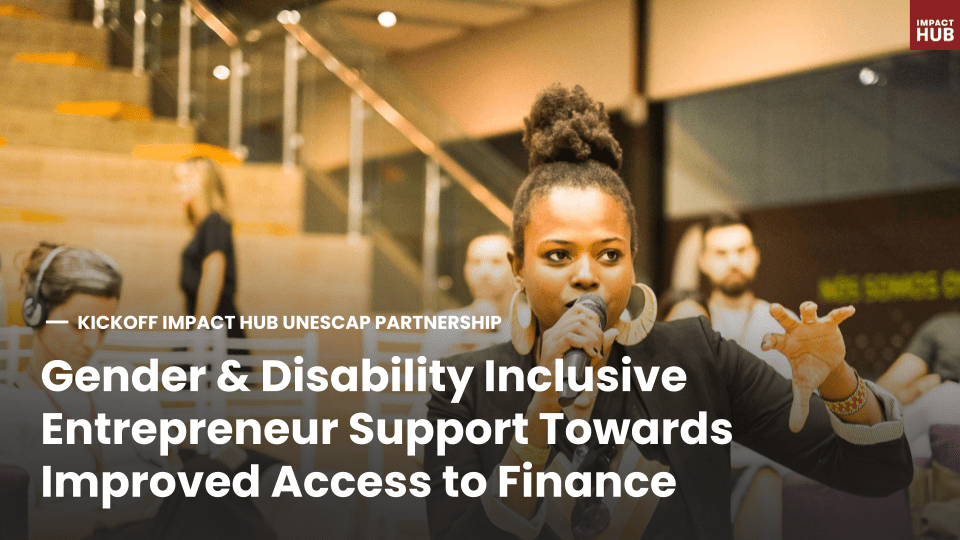Who can be an entrepreneur? The holistic definition of entrepreneurship might look like this: “The act of building an enterprise with independence, motivation, and diligence, that involves taking the initiative to start a business with creativity and innovation.” To rephrase, the process of entrepreneurship too involves multiple functions in domains of production, investment, organization, technique innovation and probably combination of all these factors (Kunwar, 2018). But, is our society designed in such a way that it enables anyone to ‘become’ and ‘succeed’ as an entrepreneur? Are our systemic structures, support mechanisms and ecosystem inclusive and what does entrepreneurship look like for people with disabilities? What are the challenges for people from different walks of life? Starting with this question, Impact Hub Network: Impact Hub Kathmandu, Impact Hub Dhaka and Impact Hub Phnom Penh partnered with the United Nations Economic and Social Commission for Asia and the Pacific (UNESCAP) to understand the context and ensure that entrepreneurship support in Asia is accessible and inclusive for women with disabilities. The partnership aims to bring together different relevant stakeholders from Bangladesh, Cambodia and Nepal, including disability-focused associations, to co-develop a methodology for disability-inclusive entrepreneurship. Rather than discussing why women with disabilities can become entrepreneurs, this research will try to understand what are the barriers and challenges and what is limiting them!

The overall objective of the partnership between Impact Hub and UNESCAP is to ensure that entrepreneurship support in Asia is accessible and inclusive for women with disabilities, with a specific focus on addressing the financing disparity and the underlying infrastructure that contributes to existing inequalities and barriers to access. The concept of inclusion advocates for the acceptance of people regardless of their differences by accepting that each person has a contribution to make in society irrespective of medical need, disability, race or gender.
What it looks like in Nepal…
The startup ecosystem in Nepal has definitely been gaining momentum, with an increasing number of entrepreneurs venturing into diverse sectors such as technology, agriculture, tourism, and renewable energy. There is also a rise in high potential and aspirational Nepali women entrepreneurs seeking extensive business and investment support in Kathmandu. This might seem optimistic because the entrepreneurial sector here is increasing with the surge of new ventures, but if we start to add layers of reality, this optimism will gradually fade. While there is growth, entrepreneurs in Nepal face challenges such as access to finance, bureaucratic hurdles, and infrastructural limitations.
To start the conversation about the different layers of reality, let’s bring more than half the population of Nepal: Women. A study on Women’s Entrepreneurial Ecosystem in Nepal: A Study Based on Kathmandu Valley says that despite constituting 52.05 percent of the total population in 2022, female participation in the economy remains relatively low (Acharya & Pandey, 2018.). This disparity is evident in women entrepreneurship in Nepal, which struggles to gain momentum. According to the National Economic Census by the Central Bureau of Statistics of Nepal, women own only 29 percent of the 922,356 establishments in the country, indicating progress but highlighting persistent obstacles. Additionally, it is difficult to conclude that these registered businesses are led and operated by women; many women registered as entrepreneurs do not actively operate their ventures, with their businesses often run by husbands or other male family members. Nepal’s adherence to cultural norms and beliefs, rooted in feudalism, hampers women’s entrepreneurial pursuits. These embedded structural and socio-cultural constraints pose significant challenges to the growth and stability of the entrepreneurial ecosystem. A recent study on Financial Inclusion in Nepal in 2023 by UNCDF states that “As of mid-June 2022, Financial Service Providers (FSPs) had distributed NPR 72.38 billion in loans intended for women entrepreneurs, benefiting 83,669 women. Nevertheless, this figure may not accurately reflect the situation, as numerous businesses are illegitimately registered under women’s names to gain access to government subsidies.” According to a survey conducted in 2021, an expanding number of women turned to informal borrowing to fulfill their daily requirements, with approximately 42% of women having sought loans from informal lenders. Only 26% of women have access to property rights, which severely limits their independent risk-taking abilities (Shrestha, 2023). Without the support of their family, many women would thus be unable to borrow from formal institutions. As per baseline study on Financial literacy of Nepal in 2022, on gender wise, financial knowledge is very low in females with a score of 38.6 percent compared to male with a score of 56.5 percent in Nepal (Nepal Rastra Bank, 2022).
Just adding the first layer of reality and data paints a grim picture in the entrepreneurial sector of Nepal. The second layer might as well add up to this, however we do not have enough and specific data to begin with- : disability. According to the National Federation of the Disabled-Nepal (NFDN), women with disabilities are among the most marginalized groups in the country, with limited access to education, healthcare, and employment opportunities. If we add both the layers together, we have women entrepreneurs with disabilities. Our common learnings from preliminary study over the past month from all the three Impact Hubs i.e. Nepal, Bangladesh and Cambodia showed almost similar findings. There is also a significant skills and training gaps highlighting a high need for investment in women entrepreneurs with disabilities.
We at Impact Hub Kathmandu, Dhaka and Phnom Penh, are trying to dig deeper into this issue for the Asia Pacific region through support from United Nations Economic and Social Commission for Asia and the Pacific (UNESCAP). Our focus lies on addressing the financing disparity and the underlying infrastructure that contributes to existing inequalities and challenges to access to finance and entrepreneurial support. What are the underlying and structural barriers for people with disabilities in entrepreneurship avenues and specifically for women with disabilities? There is a need to understand and go beyond our perception of the conventional challenges that women entrepreneurs and women entrepreneurs with disabilities might have. We are dedicated and driven to learn what entrepreneurship looks like for women with disabilities in the regions in Asia Pacific and measures to overcome these challenges and design a best practice collection as a valuable tool for the future.
Meet the team from Impact Hub Network who are driving this from the back end!

References
Acharya, U., & Pandey, C. (2018). Women’s Entrepreneurial Ecosystem in Nepal: A Study
Based on Kathmandu Valley. Westcliff University. Retrieved December 2, 2023, from
https://www.westcliff.edu/wp-content/uploads/2019/08/Acharya-Pandey-2018-22.pdf
Nepal Law Commission. (2017). (Act Relating to Rights of Persons with Disabilities, 2074 (2017). The
Act Relating to Rights of Persons with Disabilities, 2074 (2017). Retrieved December 14, 2023,
from
https://www.lawcommission.gov.np/en/wp-content/uploads/2019/07/The-Act-Relating-to-Rig
hts-of-Persons-with-Disabilities-2074-2017.pdf
NFDN. (2023). Disability Data from Nepal Census 2022 – National Federation of the Disabled – Nepal.
National Federation of the Disabled – Nepal. Retrieved December 14, 2023, from
Shrestha, S. (2023, January 28). Status of Financial Inclusion in Nepal – Nepal Economic
Forum. Nepal Economic Forum.
Baseline-Survey-on-Financial-Literacy-in-Nepal-including-Financial-Inclusion- Indicators. https://www.nrb.org.np/contents/uploads/2022/12/Baseline-Survey-on-Financial-Literacy-in-Nepal-including-Financial-Inclusion-Indicators.pdf